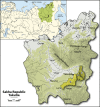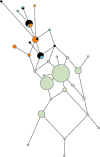Human evolution in Siberia: from frozen bodies to ancient DNA
- PMID: 20100333
- PMCID: PMC2829035
- DOI: 10.1186/1471-2148-10-25
Human evolution in Siberia: from frozen bodies to ancient DNA
Abstract
Background: The Yakuts contrast strikingly with other populations from Siberia due to their cattle- and horse-breeding economy as well as their Turkic language. On the basis of ethnological and linguistic criteria as well as population genetic studies, it has been assumed that they originated from South Siberian populations. However, many questions regarding the origins of this intriguing population still need to be clarified (e.g. the precise origin of paternal lineages and the admixture rate with indigenous populations). This study attempts to better understand the origins of the Yakuts by performing genetic analyses on 58 mummified frozen bodies dated from the 15th to the 19th century, excavated from Yakutia (Eastern Siberia).
Results: High quality data were obtained for the autosomal STRs, Y-chromosomal STRs and SNPs and mtDNA due to exceptional sample preservation. A comparison with the same markers on seven museum specimens excavated 3 to 15 years ago showed significant differences in DNA quantity and quality. Direct access to ancient genetic data from these molecular markers combined with the archaeological evidence, demographical studies and comparisons with 166 contemporary individuals from the same location as the frozen bodies helped us to clarify the microevolution of this intriguing population.
Conclusion: We were able to trace the origins of the male lineages to a small group of horse-riders from the Cis-Baïkal area. Furthermore, mtDNA data showed that intermarriages between the first settlers with Evenks women led to the establishment of genetic characteristics during the 15th century that are still observed today.
Figures





Similar articles
-
The ancient Yakuts: a population genetic enigma.Philos Trans R Soc Lond B Biol Sci. 2015 Jan 19;370(1660):20130385. doi: 10.1098/rstb.2013.0385. Philos Trans R Soc Lond B Biol Sci. 2015. PMID: 25487336 Free PMC article.
-
Mitochondrial DNA evidence for admixed origins of central Siberian populations.Am J Phys Anthropol. 2003 Mar;120(3):211-24. doi: 10.1002/ajpa.10145. Am J Phys Anthropol. 2003. PMID: 12567375 Review.
-
Investigating the effects of prehistoric migrations in Siberia: genetic variation and the origins of Yakuts.Hum Genet. 2006 Oct;120(3):334-53. doi: 10.1007/s00439-006-0213-2. Epub 2006 Jul 15. Hum Genet. 2006. PMID: 16845541
-
Autosomal and uniparental portraits of the native populations of Sakha (Yakutia): implications for the peopling of Northeast Eurasia.BMC Evol Biol. 2013 Jun 19;13:127. doi: 10.1186/1471-2148-13-127. BMC Evol Biol. 2013. PMID: 23782551 Free PMC article.
-
High levels of Y-chromosome differentiation among native Siberian populations and the genetic signature of a boreal hunter-gatherer way of life.Hum Biol. 2002 Dec;74(6):761-89. doi: 10.1353/hub.2003.0006. Hum Biol. 2002. PMID: 12617488 Review.
Cited by
-
The Evolutionary Origin and Genetic Makeup of Domestic Horses.Genetics. 2016 Oct;204(2):423-434. doi: 10.1534/genetics.116.194860. Genetics. 2016. PMID: 27729493 Free PMC article. Review.
-
The genetic legacy of legendary and historical Siberian chieftains.Commun Biol. 2020 Oct 16;3(1):581. doi: 10.1038/s42003-020-01307-3. Commun Biol. 2020. PMID: 33067556 Free PMC article.
-
High mitochondrial mutation rates estimated from deep-rooting Costa Rican pedigrees.Am J Phys Anthropol. 2012 Jul;148(3):327-33. doi: 10.1002/ajpa.22052. Epub 2012 Mar 28. Am J Phys Anthropol. 2012. PMID: 22460349 Free PMC article.
-
Tuberculosis epidemiology and selection in an autochthonous Siberian population from the 16th-19th century.PLoS One. 2014 Feb 26;9(2):e89877. doi: 10.1371/journal.pone.0089877. eCollection 2014. PLoS One. 2014. PMID: 24587092 Free PMC article.
-
The first horse herders and the impact of early Bronze Age steppe expansions into Asia.Science. 2018 Jun 29;360(6396):eaar7711. doi: 10.1126/science.aar7711. Epub 2018 May 9. Science. 2018. PMID: 29743352 Free PMC article.
References
-
- Forsyth J. History of the people of Siberia. Cambridge: Cambridge University Press; 1992.
-
- Okladnikov AP. The history of the Yakut ASSR: Yakutia before its incorporation into the Russain state (in Russian) Vol. 1. Moscow: Izdatel'stvo Akademii Nauk SSSR; 1955.
-
- Derenko MV, Malyarchuk BA, Dambueva IK, Shaikhaev GO, Dorzhu CM, Nimaev DD, Zakharov IA. Mitochondrial DNA variation in two South Siberian Aboriginal populations: implications for the genetic history of North Asia. Hum Biol. 2000;72(6):945–973. - PubMed
Publication types
MeSH terms
Substances
Grants and funding
LinkOut - more resources
Full Text Sources

